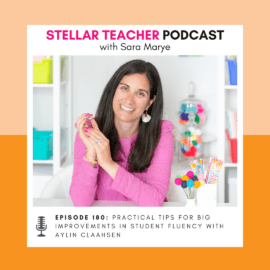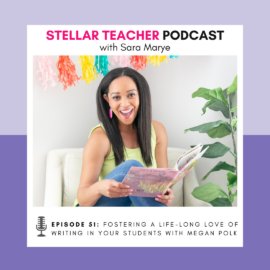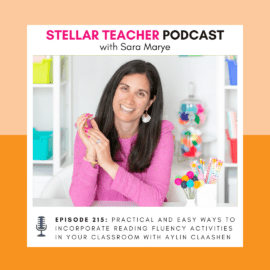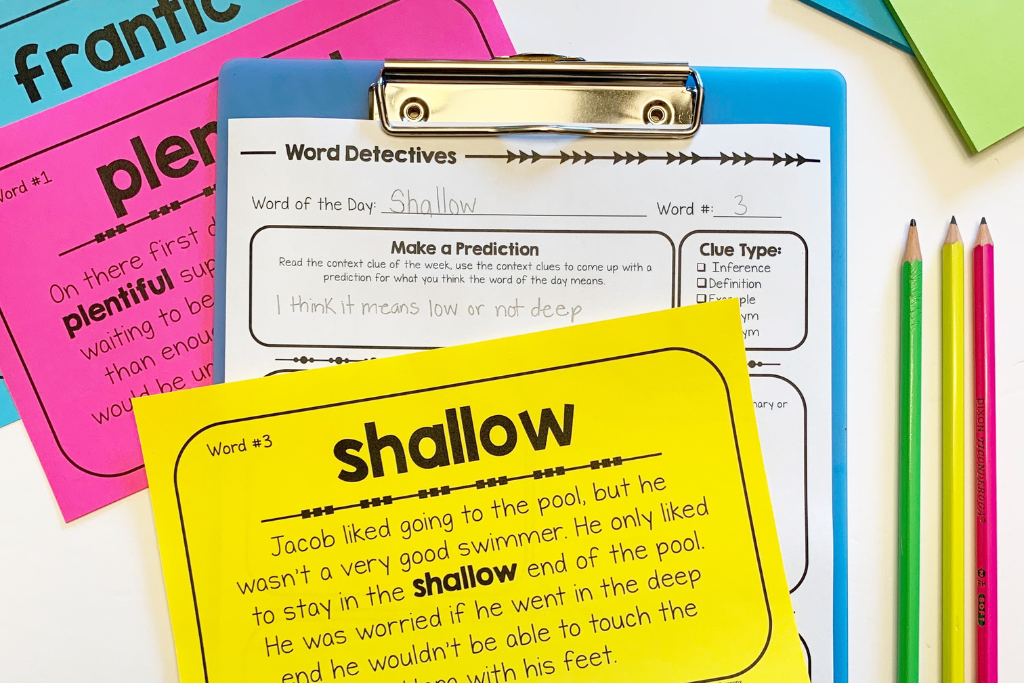
Click play below to listen to why students need the same kind of explicit, systematic instruction in writing that they do in other areas of literacy.
Writing is one of the most complex skills our students will ever learn—and one that is often overlooked. In this episode of the Stellar Teacher Podcast, I’m joined by two of the leading experts in writing instruction: Dr. Steven Graham and Dr. Karen Harris. Steven has spent more than 40 years studying how students learn to write, while Karen developed the Self-Regulated Strategy Development (SRSD) model, one of the most widely used and researched approaches to teaching writing. Together, they share valuable insights into what makes writing instruction so challenging and how teachers can provide explicit, systematic writing instruction that really works.
During our conversation, we dig into the many complexities of writing—everything from idea generation and sentence construction to transcription skills, motivation, and self-regulation. Steven and Karen also unpack what it means to use evidence-based practices in writing instruction and help us distinguish between strategies that truly make a difference and those that fall short. Their insights are especially helpful for teachers in upper elementary who often face limited time for writing and wonder how to make the most of the minutes they do have.
You’ll walk away from this episode with practical guidance you can apply right away, whether it’s structuring short but consistent writing blocks, integrating writing into reading and content areas, or helping students set goals and monitor their own progress. If you’ve ever felt overwhelmed by teaching writing, this conversation will give you clarity, encouragement, and research-backed strategies to strengthen your writing instruction.
Meet Karen
Dr. Karen Harris
Dr. Karen Harris is the Regents Professor Emeritus and Research Professor at Arizona State University. She has been an educator for 50 years, first teaching 4th grade in a coalmining community in West Virginia and then a special education teacher. She developed the Self-Regulated Strategy Development (SRSD) model of instruction, deemed an evidence-based practice by the What Works Clearinghouse for teaching writing. SRSD instruction is also validated for teaching close reading for informative and persuasive writing. Practice-based PD results in effective SRSD instruction and large effect sizes in writing among students. She is a former editor of the Journal of Educational Psychology and has authored 15 books/handbooks. She is lead author of Powerful Writing Strategies for All Students and lead Editor of the APA Educational Psychology Handbook. She has published more than 250 peer-reviewed articles and chapters for teachers and researchers and has served on multiple panels and committees.
Meet Steven
Dr. Steven Graham
Steve Graham is a Regents and the Warner Professor in the Division of Leadership and Innovation in Teachers College. For 47 years he has studied how writing develops, how to teach it effectively, and how writing can be used to support reading and learning. His research involves typically developing writers and students with special needs in both elementary and secondary schools, with much of occurring in classrooms in urban schools.
Graham is the former editor of Exceptional Children, Contemporary Educational Psychology, Journal of Writing Research, Focus on Exceptional Children, and Journal of Educational Psychology. He is the co-author of the “Handbook of Writing Research,” “Handbook of Learning Disabilities,” “APA Handbook of Educational Psychology,” “Writing Better,” “Powerful Writing Strategies for all Students” and “Making the Writing Process Work.” He is also the author of three influential Carnegie Corporation reports: Writing Next , Writing to Read , and Informing Writing.
In this episode on explicit, systematic writing instruction, we share:
- Why writing is such a complex skill for students to learn and teachers to teach.
- The essential features that make a writing practice truly evidence-based.
- How the SRSD model supports students through self-regulation and strategy use.
- Practical ways to structure systematic writing instruction when you have limited time.
- How to integrate writing into reading, science, and social studies for maximum impact.
- The connection between writing and reading growth—and why balancing both matters.
- Simple, actionable steps teachers can take to strengthen systematic writing instruction right away.
Resources:
- Join The Stellar Literacy Collective
- McGraw Hill Science of Literacy Library
- The Self-Regulated Strategy Development Instructional Model: Efficacious Theoretical Integration, Scaling Up, Challenges, and Future Research
- Is Evidence-Based Writing Instruction Emotional? with Dr. Karen Harris. Literacy Matters: Empowered Conversations
- Blog Post: Four Reasons Writing Instruction Needs a Makeover—and Evidence-Based Solutions
- Sign up for my Private Podcast: Confident Writer Systems Series
- Sign up for my FREE Revision Made Easy email series
- If you’re enjoying this podcast, please leave a review on Apple Podcasts!
Related episodes and blog posts:
- Episode 259, From Sentences to Essays: The Writing Sequence That Works
- Episode 258, From Sentence to Paragraph: A Peek Inside Our Writing Routine
- Episode 257, How to Strengthen Student Writing—One Sentence at a Time
- Blog, Why Sentences Matter: The Building Blocks of Strong Writing
Connect with me:
- Join my newsletter
- Shop my TPT store here
- Subscribe to our YouTube channel
- Instagram: @thestellarteachercompany
- Facebook: The Stellar Teacher Company
More About Stellar Teacher Podcast:
Welcome to the Stellar Teacher Podcast! We believe teaching literacy is a skill. It takes a lot of time, practice, and effort to be good at it. This podcast will show you how to level up your literacy instruction and make a massive impact on your students, all while having a little fun!
Your host, Sara Marye, is a literacy specialist passionate about helping elementary teachers around the world pass on their love of reading to their students. She has over a decade of experience working as a classroom teacher and school administrator. Sara has made it her mission to create high-quality, no-fluff resources and lesson ideas that are both meaningful and engaging for young readers.
Each week, Sara and her guests will share their knowledge, tips, and tricks so that you can feel confident in your ability to transform your students into life-long readers.
Tune in on your favorite podcast platform: Apple, Google, Amazon, Spotify, Castbox, and more! If you’re loving this podcast, please rate, review, and follow!
Podcast (stellar-teacher-podcast): Play in new window | Download
Sara
Hey there. Welcome back to the podcast. I’m so glad you are tuning in today because we are having a conversation all about how to make writing instruction more effective, and how we can make sure that we are aligning it with what research says actually works. Today, I am joined by two incredible guests, Dr. Steven Graham and Dr. Karen Harris.
Steven Graham has spent over 40 years researching how students learn to write and how teachers can best support that process. I know I’ve mentioned many of his articles and research studies on this podcast in the past, so I’m so excited that he is joining us today.
Karen Harris is the developer of the SRSD model, which is one of the most widely used and well-researched approaches to teaching writing, and she’s going to talk about that a little bit in today’s episode as well. Both of them have authored books, led major studies, and worked directly with schools to improve writing outcomes for students of all ages, so they definitely know what they’re talking about.
Before we dive into the episode, I want to give a quick shoutout to our friends at McGraw Hill for helping connect us with today’s guests. They are doing really great work to bridge the gap between research and classroom practice. They also have a free Science of Literacy library, which we’ll link to in the show notes in case you want to check out some of their resources.
In today’s episode, we talk about why writing instruction is often overlooked, what evidence-based writing practices actually look like, and how writing instruction needs to evolve as students move from the primary grades into upper elementary. I think this is a conversation you’re really going to enjoy. Let’s go ahead and jump right in.
Hi, Karen and Steve. Welcome to the show. I am so excited that we get to sit down and chat all about writing today.
Steven
We’re really glad to be here.
Karen
Thank you. We’re really excited to be here.
Sara
Yeah. So let’s start with the big picture. We know that writing is oftentimes an area that is challenging for schools and teachers. Why do you think writing instruction continues to be such a struggle, maybe especially in upper elementary—third, fourth, and fifth grade?
Karen
Okay, well, I think there are a lot of reasons, but let’s just take one for now. For quite a long while, we have focused on reading as the core of literacy. And I think there was an assumption by a lot of people that if you did a sufficient job of teaching reading, writing and other language abilities would come along naturally. There was also the whole language movement, which emphasized that writing should be learned naturally, without a lot of—or any—explicit instruction. Those are the two reasons I would note.
Steven
Yeah, I’d add a couple of other things as well. One is that teachers don’t get a lot of preparation at the university or college level in terms of how to teach writing. In some of the national surveys we’ve done, teachers often say that at this grade level, they’ve had one or two classes within a course focused on writing. And because writing wasn’t taught much when they were in school, they didn’t necessarily have great models for how to do it either.
I think another issue worth mentioning is that, in many ways, writing is a prisoner of time. Now, I wish I was the first person to say that, but I’m not—the National Commissioner of Writing pointed this out in 2003. We have a very crowded curriculum, and getting anything new into that curriculum can be quite challenging. Writing is a really complex skill, and it takes time to teach, learn, and practice. So I think those are two issues we also have to address as we move forward.
Sara
Yeah, and I mean, to your point, I think back to my teacher education program, and I don’t remember having any courses on how to teach writing. I had specific classes on how to teach math and specific classes on how to teach reading, but I had to sort of figure it out as I went along, and I did not do a very good job when I first started. That’s for sure.
Karen
Right. And again, there’s that assumption: if you can read, you’re good to go with writing. In addition, we know from research that it’s rare for a university to offer a required course on teaching writing. We’ve been at several universities and have been unable to get a required course on teaching writing at any of them. So the resistance is a huge problem in academia.
Sara
Yeah, for sure Steve, one of the things you mentioned is that writing is such a complex task, and that really adds to the challenge. Can we talk a little bit about why writing itself is so complex?
Steven
Well, there’s a lot you have to orchestrate and a lot that you have to learn. Let me just run down some of these. At a very basic level, you could think of writing as having a series of production processes. One of those is ideation—you have to gather information, you have to have something to say when you write. So if you don’t have a lot of information on a particular topic, or you haven’t learned much about that topic, then that’s a challenge.
But also, in terms of thinking about this, we have to take our ideas and turn them into sentences. That involves sentence construction skills—translating ideas into text that has appropriate grammar and conveys your meaning as intended. Oral language provides a vehicle, but you still have quite a bit to learn to make that really solid.
In terms of writing, we also have to manage transcription skills—handwriting, spelling, typing. And I haven’t even mentioned goal-setting, planning, and everything that goes along with that, including drafting and then revising. So if we just think about the production processes and nothing else, that’s a real challenge.
I’d also add that motivational factors play a role—your beliefs about writing, how important it is, how good a writer you think you are. There’s also your knowledge about the functions of writing. Writing a story is different from writing an informative piece, and the basic building blocks you use to put that together are different as well. So there’s a lot going on, a lot for kids to orchestrate.
Karen
I would add that writing requires an intense amount of self-regulation. That includes being able to set clear goals, monitor progress toward those goals, and adjust what you’re doing based on your monitoring. It also involves assessing your own performance and feeling good about what you’ve accomplished. Those are the four basic forms of self-regulation that are an important emphasis in SRSD.
In addition to motivation, there are a lot of other affective responses to writing. Writing is hard. It’s difficult, and this does overlap with reading, although they are somewhat different beasts. If you feel daunted, incapable, or don’t have deep genre knowledge and writing strategies for each genre, you’re far more likely to give up. We know that it’s common in this country that by third grade, the majority of students in most classrooms dislike or even hate writing. That’s largely due to what they perceive as their personal failure, when the real failure is that they’re simply not being taught in effective ways.
Sara
Yeah. I mean, you guys just listed off so many complexities of writing. It’s no wonder that it’s a challenge for teachers. However, I also know, based on a lot of your work, that there are definitely effective strategies—ways we can provide high-quality, effective instruction to our students. I know the term “evidence-based instruction” gets thrown around a lot in education, but when it comes to writing, what features make something an evidence-based practice?
Steven
So there isn’t exact agreement on this, but generally, evidence-based practices are those supported by high-quality research showing that they work. This research has been replicated multiple times. So it’s not just in one context or with one set of students—you see these instructional procedures having a positive effect over time.
Another part of this that’s often missing is that evidence-based practice is meant for teachers to use the best available knowledge, along with their knowledge of their students, classroom, and writing, to bring those together. This doesn’t mean disregarding the experience and knowledge teachers have gained over time—they often know what works with their students. But it does mean bringing into the classroom those strategies for which we have solid evidence of effectiveness.
Karen
I’ll add just a little bit to that. It kind of helps to know what evidence-based practice is not. We see a lot of people arguing that their work is research-based, and they leap from that to evidence-based. Most people promoting a method are relying on research that indicates that some of the components they’re using have evidence behind them—they are not testifying to research on their method as a whole.
So when you buy into a whole method, it’s really important to understand the difference between “it’s research-based,” which means we looked at the research and know it’s solid if children can plan, versus how they teach planning—or anything else—which matters a great deal. We also have the issue that testimonies are not evidence-based. They don’t create evidence. You’ll see a lot of testimonies on websites promoting particular approaches.
Finally, there are approaches that work for some students—there’s no doubt whole language works for some—but unfortunately, not all, and often not the majority. We don’t know what’s happening outside the classroom for those children who do thrive. I’ve talked to many parents, and in our personal experience, we were supporting reading and writing at home. Our daughter wasn’t learning a lot of what she knew about reading and writing in the classroom in kindergarten, first grade, or second grade. So we did that from home. Other people have tutors, so it’s really murky. Whereas, if you have high-quality experimental research, no factors like that are the primary cause of what’s happening, and what is happening is well-documented.
Sara
Yeah, and I think it’s important that you highlight both what evidence-based practice is and what it isn’t, because that can help teachers distinguish between, “Am I using an evidence-based practice or not?” I’d love for you guys to share a little bit about—most of the teachers listening are third, fourth, and fifth grade—they always want to know, “What should writing instruction look like in my classroom?” Can you give them your insight? What should they be doing with their writing block?
Steven
So I have five words that kind of cover the key points here. Four of these are strongly based on evidence. The other one—the evidence has slipped away from me a little—but I still think it’s important. I’ll start with that one: kids need to write. That’s the whole purpose of the game. Just like anything else—let’s say soccer—there’s the fun of playing the game, participating in it. Your skills improve through practice. But if that’s all you do, it’s not enough. The evidence suggests that you get very small gains that won’t really move you forward.
The second word is support. There’s good evidence that if teachers—and also peers—support students as they write, students’ writing improves over time, not only in what they’re working on but in their writing overall. That support can look like providing constructive, manageable feedback, planning before writing using advanced organizers or reading texts to gather material, and setting goals—both teacher goals and student goals. Those are three examples of evidence-based practices in this broader area.
The third construct is teach. We don’t want to leave that out. Teaching is critical to advancing writing. If I had to narrow it down to three things, teaching the processes or strategies for planning effectively in different genres, revising and editing text, and drafting. Another thing is teaching students to construct sentences, which we already mentioned, and transcription skills as well.
A fourth thing I think is particularly important comes from watching excellent teachers: create an environment in which kids flourish. So far we’ve talked about write, support, teach, and create. Finally, we want to connect writing, reading, and learning. The evidence is clear: if you teach writing, kids get better as readers; if you teach reading, kids get better as writers. The basic purpose of reading and writing, in many cases, is to help students learn. We want to make those connections.
So my five words here would be: write, support, teach, create conducive environments, and connect reading, writing, and learning.
Sara
I love that, especially the part about creating an environment that is conducive to learning. Sometimes we forget it’s not just about the materials we’re teaching or the content—it’s about how we create that environment in our classroom, and whether kids actually want to learn and participate.
Karen
In addition, I’d like to add a couple of things. Steve already mentioned the issues with time, and in study after study, time for writing is clearly one of the leading obstacles to getting an effective writing program in place. Effective writing instruction takes time. Students probably need about the same amount of time in writing that they currently get in reading. Evidence points to writing being just as hard to learn as reading is for many kids, and one of the things teachers have to do is fight for that time.
When we work in schools where the principal is on board, students are given the time they need to implement what we call Self-Regulated Strategy Development, or SRSD. When they’re given that time, it’s amazing to see the growth that children achieve, and teachers are excited. Many teachers feel incompetent teaching writing. I just read an interview with a teacher who said, “I just did less writing because I didn’t really know how to teach it, and I didn’t have anything to help me.” So time has to be fought for and established.
SRSD is an evidence-based approach to writing instruction. We won’t get into all the details, and it’s not only for writing—but that’s where most of the research has been done. It integrates everything we know about effective teaching and learning into a method teachers can adopt, with the integration already built in for them. It’s highly flexible and has to be individualized—you have to make changes that fit your students in your classroom. It produces the largest effect sizes, far larger than any other instructional approach in writing, including writing workshop and many other commercial programs out there.
Now, yes, we created SRSD, but we are not selling it. We have a volunteer relationship with two organizations. I’ll, for example, mention SRSD Online. They offer wonderful SRSD courses for individuals, whole schools, or groups. Teachers come out of that professional development with practical experience—they’ve used all the materials, tried strategies in their classrooms, and learned to put it all together. SRSD addresses every one of those five—and six—critical things that Steve noted.
The other organization is Think SRSD. We don’t make any money from this, and I think it’s important for people to know that, because in many cases, people promote a curriculum or program they’re literally making millions of dollars from. We don’t do that. Our motivation is the integrity of the work—we want it to work in schools.
We do have a book, Powerful Writing Strategies for All Students (2008). It’s older, but still completely relevant. All those strategies still work, and the profits from that book go to children and family shelters, so we’re not financially involved in promoting SRSD. Our motivation is simple: it works, let’s get it in schools.
I also want to add that you don’t have to give up everything from Writer’s Workshop to integrate SRSD. In fact, anyone doing Writer’s Workshop who studies SRSD will find that many characteristics of Writer’s Workshop are already present in SRSD. I was a huge Donald Graves fan. Interestingly, at the end of his career, he gave an interview where he was asked, “What do you think about writing in schools today?” He said, “Well, I’m concerned. I see a lot more writing happening,” which was a major goal for him, “but I don’t see good writing.”
When you combine some of the best aspects—Steve already mentioned a few, like writing community and faith in the learner—we tell students they have to put forth the effort to learn the strategies and use them. And the strategies are kind of fun. Kids really get into them—they all have acronyms, fun chants, and other engaging elements, especially for the grade levels you’re talking about. We’ve even had Power Ranger Writer teachers and all kinds of fun things happening.
So when you look at how Writer’s Workshop and SRSD can work together, it should help most teachers who want the best for their students. Take a good look at SRSD. We do have a new book in the works. It won’t be out for a couple of years, but it will make tons of new strategies for reading-to-learn and writing for different purposes accessible to teachers, with all the materials online. We’re excited about that. I wish it could all happen faster, but I’d add these last factors.
Sara
Oh, for sure. I’m so excited for your new book to come out, and we’ll definitely link to your previous book, as well as these resources, in our show notes. I think it’s incredible that you’ve committed so much of your work to making sure teachers actually have effective tools—access to things that really work.
Karen, I want to follow up on the time aspect, because I know that’s such a huge point of contention for teachers. They either don’t have enough time in their schedule or they don’t know how to use the time they do have. For a teacher who’s feeling limited by their time, do you have any advice or encouragement? For example, if they don’t have a dedicated writing block or don’t have enough time, what should they do?
Karen
Lessons in SRSD aren’t time-based—they’re mastery-based, moving toward meeting goals. And goals are differentiated within a classroom. When I taught fourth grade, I had primer readers through sixth-grade readers, and I also had very limited time for writing. I get that. In addition to fighting for the time they need, teachers also need consistent days over time.
If you’ve only got 30 minutes a day for writing, you can still do SRSD—it’ll just take more days. Some of our teachers only have 30 minutes, so time is still an issue, but if you can get a consistent block that’s left alone, that helps. Another thing teachers report is that when something has to give—either by their choice or leadership’s decision—it’s often writing that gets cut. But you don’t have to do more than 30 minutes, preferably three times a week. Thirty minutes, three times a week, would be awesome. More is better, and you still need a bit more time to integrate all those skills—transcription, spelling, and so forth—that Steve mentioned. We’ve shown that this can be done in first and second grade, integrating the two in 45-minute sessions, three days a week.
Steven
I have a couple of suggestions here, and they’re really about bringing reading, writing, and learning together. One meta-analysis we did a while back looked at what happens when you balance the time spent teaching reading and writing—roughly 60/40. What we found is that, compared to other approaches, students improved in both reading and writing.
So one thing to think about is that when you bring writing into the fold, students get better as readers. How can we do that? Something like spelling and word decoding—phonics—can be taught together. We’re working on both at the same time. Also, when we look at stories and analyze what constitutes a story, we can use that knowledge to help students construct stories they write. It has a positive effect in multiple ways, so we want to look for ways to do that consistently.
Another point is that in upper elementary grades, we’re also teaching social studies, math, and other subjects. Writing is a powerful tool for learning. When students write about what they’re learning, it enhances understanding and makes the content more memorable. We want to find ways to integrate writing into social studies, science, and math—so it contributes to learning while also making writing a more prominent part of the elementary curriculum.
Karen
Let me add a little bit here. The study I just mentioned—actually two studies in first and second grade—focused on close reading to learn, and the kids loved it. They really loved learning to mark up text, which gave them a basis for making notes and structuring what they were going to write. In one study, where we actually measured reading comprehension, we also saw improvement in reading comprehension, which makes sense. They were rereading, learning to underline key points, and using strategies from close reading for learning. Then we taught a strategy for writing to inform, using science topics. This was pretty heavy-duty stuff for first and second grade, and everything they read was at a first-grade reading level.
Working with Young Sook Kim at the University of California, Irvine, we added handwriting, sentence construction, and academic language development. That includes the words for what they’re doing, the part they’re working on, the genre elements, and the use of effective vocabulary in writing, among other things. The students thrived. The growth was remarkable—effect sizes were near or over one, which means the whole class moved forward around the standard deviation, something that nothing else achieves.
Why does it work? First, current instruction is often poor. Second, SRSD includes all the evidence-based aspects of teaching writing. It takes a little time to learn, but it’s not that difficult, and most teachers find they’re already doing parts of SRSD. One teacher said something brilliant: “I was doing some of this. I think I was doing it pretty well, but I didn’t have any idea how to put it all together, and that’s the workload that’s already done.”
I’d also like to mention that if you’re going to post things, we have a 313-page resource list for SRSD, with numerous free videos online showing how instruction works at each stage, all kinds of documents, and even downloadable lessons. My sweet spot has been third through fifth grade for the last couple of decades—reading to learn and writing to inform or persuade. For first and second grade, we went further. We already have the second-grade materials online for free, and we’re fine-tuning first-grade materials. We also have third through sixth-grade materials for teachers and students, also available free online. I can send you the resource list if you’d like.
Sara
Oh, absolutely. I know my teachers would love those resources. They’re always looking for more writing materials, so anything you’re willing to share, they’ll take advantage of.
Karen
That list also includes a link to the two studies, which show pre- and post-work by the students. That’s in the research article, but the supplemental materials include a PowerPoint with student work and a deeper description of the instruction.
Sara
One thing I think sometimes teachers struggle with is, they hear all of this and think, “Okay, this sounds great. I’m motivated to improve my writing instruction, but where do I even begin?” If a teacher is listening and realizes they need to make some changes to their writing instruction, what’s maybe one small shift they can make, or one step they can take to become a better writing teacher
Steven
I’m going to suggest something that isn’t actually a change in the classroom, but it leads to a change in the classroom. I’m drawing on a teacher our daughter had in first and second grade. At the start of the school year, the teacher invited all the parents in. Usually, they talk about reading and math programs, which she did, but she also had a plan for what she was going to do across the year in writing—how she was going to start and what she was going to focus on. She said it was a flexible plan that would change as she went, but I think one important thing is that you can start with a plan that considers all the different aspects we’ve talked about and how you’ll bring them to fruition.
A simple way to think about this is: we want kids engaged in the processes of writing. One step is just to have kids start writing. They might write a piece where you encourage them to plan, and then you integrate strategies into that. In your reading program, you might integrate spelling instruction. You can start layering these things in. My personal take is: start with writing, then build and strengthen it for your students. Always start with a plan—that’s the safest bet.
Sara
I think that’s encouraging for teachers. They just need to start with a plan. It can be flexible, it can change—they just need to get started. Karen and Steve, thank you so much for joining me today. You’re both a wealth of knowledge when it comes to writing instruction, and I really appreciate you sharing it with my audience.
Karen
Thank you.
Steven
Thank you very much.










Leave a Comment
You must be logged in to post a comment.